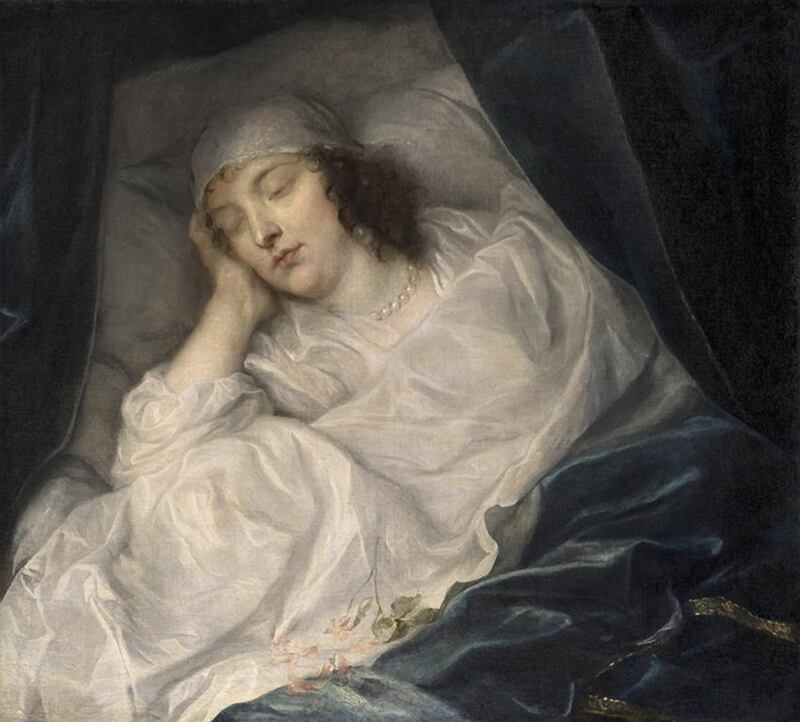The journalist-turned-author Hermione Eyre's debut novel Viper Wine opens with a reproduction of Anthony Van Dyck's portrait Venetia, Lady Digby, on her Deathbed (1633). The 33-year-old makes for a serene model, adorned with an elegant pearl necklace and earrings, the faintest rosy hue on otherwise pale cheeks, the petals of a single rose, a delicate memento mori, shed across the white counterpane. In the bottom right corner of the scene, a coil of embroidered brocade lies half hidden in the enveloping folds of the deep blue counterpane, a "snake, twisting first into the form of a blanket's gold-enamelled hem, and then into the guise of a viper's scaly back". As Van Dyck paints, Eyre imagines "all the murmours that he had ever heard resonated through his brush", this serpent of brocade a nod to the most beguiling of them all – that Venetia Stanley was a devotee of the notorious but deadly beauty tonic, Viper Wine.
These are the facts of the case: a famed society beauty, the much beloved wife of Sir Kenelm Digby, alchemist, explorer, philosopher, courtier and son of a gunpowder plotter, passes away unexpectedly in her sleep. The cause of her untimely death is unknown, but there are whispers that her insatiable appetite for the Venetian Viper Wine is to blame. From these historical footnotes, Eyre breaths new life into the court of Charles I, a world both wildly alien to our own but also uncannily familiar.
Once a woman “more spoken of than seen, like a great sight of nature, a cave or a crystal, Wookey Hole or the Badbury Rings”, Venetia inspired Ben Jonson’s poetry and duels between battling suitors. But a life of lead-based cosmetics has laid waste to her once famous face; she can feel “a new coarsening in her hair” and is tormented by the wobble of her “puckered thighs”. In desperation she begs Sir Kenelm to mix her an elixir of youth. He refuses – he loves his wife despite her sagging flesh and crow’s feet, and he’s all too aware of the deadly properties of the supposed “cures” she’s after. Venetia, however, is not to be discouraged, finding a more than willing peddler of the Viper Wine she lusts after in the plastic-faced apothecary Lancelot Choice. Soon she blooms again, her skin tightens and glows, but as any devotee of Botox proves, once begun, a regime of improvement is hard to break. And she’s not the only one guzzling the toxic brew.
Eyre draws continual parallels between the increasingly crazy beauty and plastic surgery industries of today – “I go to Dr Sebagh’s and have the ‘vampire facelift’,” confesses the actress Anna Friel. “They take a phial of blood from your arm, separate the plasma and inject it into your face” – and the practices of the 17th century, a society perched precariously between the realms of magic and science. These opposing strands converge in the figure of Sir Kenelm himself, a man just as easily found at work in his state-of-the-art scientific laboratory as catching moonbeams under the stars. Having accepted this vein of magical realism that runs through the novel, it comes as no surprise to discover that Sir Kenelm is “like a string that vibrated with strange frequencies”: “haunted by the future”, his life pulsates to the lyrics of David Bowie, he quotes Neil Armstrong, can read Java Script, dreams of Naomi Campbell and holds press conferences with the likes of Michael Parkinson and Jeremy Paxman. It sounds mad, and it is, but Eyre has worked her own magic to ensure it is so in an entrancing and perfectly plausible way.
In many ways the novel is reminiscent of Sofia Coppola’s 2006 film Marie Antoinette, a historical remix that perfectly captured the indulgence and indifference of the French court. Coppola’s masked ball scene set to Siouxsie and the Banshees’ Hong Kong Garden, for example, becomes Eyre’s timeless royal masque, “a vast crowd of moshers, waltzers, pipers, ravers, tranceheads, and Pan himself was calling the tune” – that tune being Joy Division’s Love Will Tear Us Apart. Though Coppola’s critics accused her of falling short in terms of historical accuracy and idiom, Eyre’s attention to tone and detail is flawless. Viper Wine is a dazzling postmodern baroque carnivalesque.
Lucy Scholes is a freelance journalist who lives in London.
[ review@thenational.ae ]






